We love our KISS wind generator, with a bit of breeze, it just twirls and provides free electricity all day long. We even subconsciously measure the wind speed with it – if the wind pipes up dramatically overnight, the change in the background hum alerts us. Until it gets up to over 20-25, ours doesn’t go into “helicopter take off” mode, which means the thermostats inside the KISS open to let the blades spin freely without overheating the wind generator — when the heat drops sufficiently, the thermostats close automatically to allow it to generate electricity again without us having to do a single thing, except use the amps! 🙂
If you’re trying to decide if a KISS is right for your boat, we recommend you talk to John & Libbie at svHotwire.com. In fact, John has been devoted to alternate energy systems, wind and solar, since before “green” was fashionable. So if you’re thinking of installing an alternate energy system aboard, you would do well to give him a call first — find him at the website above, call 727-943-0424 or e-mail at hotwiregam@aol.com. If you want the FAQ’s about generating electricity with the KISS, click here to go to Hotwire’s FAQ covering any questions you could have about a KISS wind generator
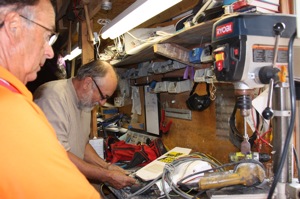
When our KISS wind generator decided to take a permanent vacation after almost 10 years, we did the normal diagnostics (see below). When that failed, we called John. Since we were only a couple hours south, we took the KISS to him and he diagnosed a failed slip ring (the slip ring is the technical name for a small black “doodad” in the wires between the wind generator and the wiring that allows the KISS to rotate freely without ever having to worry about the wires twisting). In over 10 years, John’s never seen one fail, so ours was obviously just a problem child! Note: we decided not to replace the slip ring which instantly fixed the KISS’ problem. We’ve never known any cruisers without slip rings (like the boat across the dock and many cruising friends) that had one and they never had any problem with the wires getting hopelessly twisted – we’ll just watch and not let it freely rotate 360 degrees over and over and over.
Before the diagnostic troubleshooting information, below, a few quick comments. As with any system aboard a cruising sailboat, especially systems that have served us faithfully approaching 10 years now, they may require some maintenance. Over the years, we’ve had to replace the bearings which wasn’t a problem. If you need instructions, click here to go to the Hotwire How To Overhaul a KISS Wind Generator page.
(NOTE: The original instruction manual was on the KISS inventor’s site which is no longer available. John at s/v Hotwire is the current manufacturer and has some instructions on his HotWire page. If you have questions, call John at (727) 638-1248.) If you have the manual aboard, as we did, it contains bearing replacement instructions and you won’t have to worry about an internet connection, we also carried a spare set of bearings.
We also had a blade get caught in our tether in a squall in the San Blas Islands and severed the blade. It happened as we were anchoring in the Western Lemon Cayes and all of a sudden the entire boat was vibrating – David thought we’d lost the transmission (right as we put it in reverse to back the anchor down). But I happened to glance behind me and upward and saw the problem immediately. As soon as we shut down the electric power switch, the KISS blades stopped and miraculously so did the vibration! The San Blas are relatively isolated and we were not going back to civilization, so we resigned ourselves to no wind power for the next few months … until another boat had spare blades they loaned us for the winter and we replaced them when we returned the following winter cruising season (another advantage of being a commuter cruiser!). The cruising family is a wonderful thing!
But this winter, our KISS decided to take a vacation, then came back – all on it’s own and worked perfectly for another few weeks before it got contrary and decided it wasn’t going to work at all. The symptoms were obvious – it didn’t spin. I don’t care how much wind we had, it didn’t spin. Hmmm…. something’s not right. 🙂 So we got our the manual and started troubleshooting.
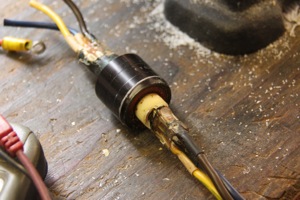
TROUBLE SHOOTING TIPS AND TRICKS – directly from the KISS Wind Generator website, click here if you want the real thing.
Hopefully you won’t ever have a problem with your unit but here are some tips to isolate and correct some of the more common problems.
No output This is virtually always due to a loose or corroded connection. If you can wiggle or move any of the electrical connections you will get an open circuit and thus no output. It may also be due to a failed diode block. See below.
Low output About half the published output and a rumble and vibration from the motor. This is again due to a loose wire but also might be due to some of the diodes in the diode block having failed.
Squeek at low speeds This is due to the oil seal on the rotor shaft becomming dry. Squirt some CRC on to the rotor shaft.
How can I tell if the motor is OK Disconnect the three wires from the wind generator at the switch. Measure the resistance between each possible pair of wires. The resistance should be about .6 ohms. If you have continuity then the wind generator must make electricity when it spins. If you get an open circuit then one of the internal thermostats has failed.
How do I check the diode block Disconnect all wires from the diode block. Set the multi-meter to the diode measurement setting. Place the common probe on the aluminium heat sink that has some of the fins “missing”. Push down with the positive probe on the copper tabs on each of the three central studs. You shoud get reading of about .48 ohms. Repeat with the common probe on the three studs and the positive probe on the other heat sink.
 checking the diode block
checking the diode block
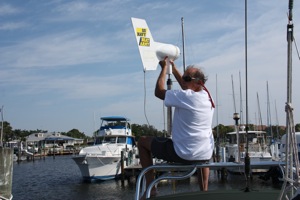
And remember, if you still have questions after all this, call John at svHotwire, the USA KISS dealer, contact info above.
Do you have a KISS wind generator? Do you have information to share that might be useful to other cruisers? Please leave a comment! Cheers! Jan
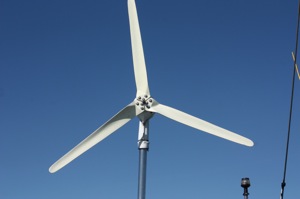

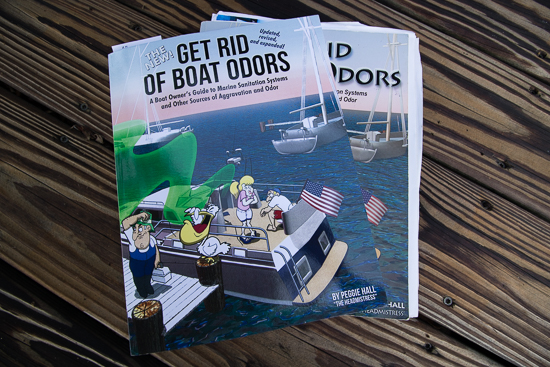
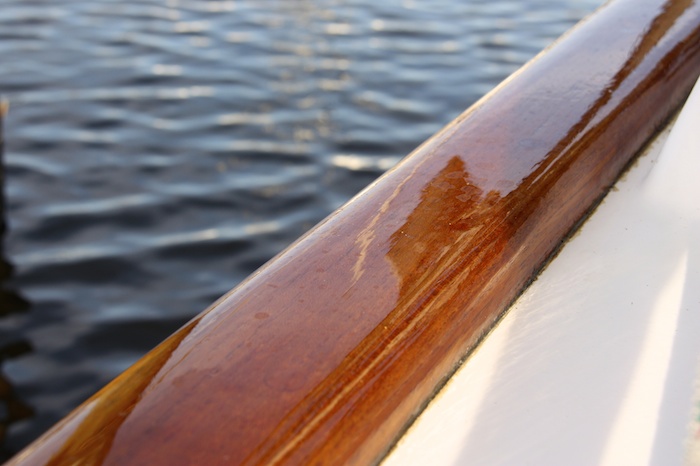







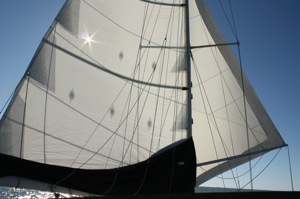
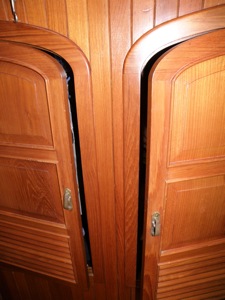
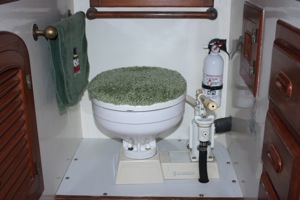
Is their any way to place a meter(perminet) on the kiss generator to monitor its effectiveness? With maybe a momentary button on it so as not to siphon amps from the12v system?
No clue Ron — that would be a question for John Gambill, the KISS distributor. John’s contact info is at svhotwire.com. Good luck! Jan
Very easy — it’s a simple 0 – 20 Amp meter … in series and it uses no power.
I use one not only to see it is working but also to know well to shut it down. If it pegs the gauge at 20+ amps …. it is probably time to shut her down.
Get a 0-30A meter. You’ll peg the 20 frequently!
Looking at replacing an old airx with blue blades and was wondering how the noise level is with the Kiss.
I’d say the noise level is comparable to other wind generators, maybe a bit less. Big advantage for us was being able to buy parts in a hardware store in Roatan when our bearings fried in the outer bands of Hurricane Ida several years ago. But not sure the KISS is still manufactured, I heard a rumor that John at HotWire retired. Haven’t checked it out. Cheers! Jan
A: John is, indeed, making them here in the US. He bought the company and molds from the founder shortly before he died.
B: He makes new blades and the original style, and matches them for weight.
C: John has retired to the degree that he’ll no longer do shows. He’s still one of the premiere customer support guys in the industry. He will entertain offers to buy his company, but is still at it from his shop.
D: “B” said, if you don’t balance them dynamically, and be very fussy about it, you won’t get the best performance, nor the quietest experience. We did/have, and even in the couple of weather events we’ve had here in the last few days, our KISS never made more than a Whiiiiisssssh, while our rafted-up neighbor’s new black-bladed, droopy tailed gen howled before it self-braked. We pegged our analog ammeter at 30+ several times on Friday and again this morning. Because it was persistent, vs gusty as today, Friday’s event had a couple of thermo-shutdowns, but it quickly came back on line once it had cooled.
Generally speaking, you can take sustained 15 knot winds, and 35 knot gusts, without tripping the thermal breakers.
I echo Jan’s serviceability commentary. Bearings and the seal are common-as-dirt items at your local auto parts store.
HTH
L8R
Skip
Morgan 461 #2
SV Flying Pig KI4MPC
See our galleries at http://www.justpickone.org/skip/gallery !
Follow us at http://groups.yahoo.com/group/TheFlyingPigLog
and/or http://groups.google.com/group/flyingpiglog
“Believe me, my young friend, there is *nothing*-absolutely nothing-half so
much worth doing as simply messing, messing-about-in-boats; messing about in
boats-or *with* boats.
In or out of ’em, it doesn’t matter. Nothing seems really to matter, that’s
the charm of it.
Whether you get away, or whether you don’t; whether you arrive at your
destination or whether you reach somewhere else, or whether you never get
anywhere at all, you’re always busy, and you never do anything in
particular; and when you’ve done it there’s always something else to do, and
you can do it if you like, but you’d much better not.”
THANKS Skip for the update on HotWire/John. He’s one of our very favorite people & your comment about customer support is exactly our experience. Glad to hear. BTW, if you’ve never been, a trip to John’s shop is a blast! You might learn things you didn’t know were possible – like his truck that ran on used vegetable oil that restaurant owners gladly supplied after they were done with it. 🙂 Cheers! Jan
I recently had a problem with a KISS on a friends boat. I noticed it wasn’t turning and asked the owner about it. She released the electric brake, but still no go. I then turned the blades and heard a grinding sound. Ahha thinks I, bad bearing. We bought new bearings and then disassembled the generator. Nope bearings were fine. Some how the rear bearing seat had degraded and the rotor was grinding on the stator. Is this fatal or does it matter?
It may not have posted yet, but I answered that with a link to my latest rebuild, which was major.
Write again if it doesn’t show up…
Well,dangit, apparently it got lost in the ether.
http://skip.justpickone.org/gallery/index.php?mode=album&album=Flying+Pig+Refit+2011-2012%2FLast+Minute+Stuff%2FKiss+Wind+Generator+Rebuild is a link to my most recent major rebuild occasioned by lengthy immersion in fresh water (don’t ask)…
If you don’t have pieces of magnet missing, and you meter the leads and get the right response, you’re good to go.
KISS recommends cleaning the area and the silicone ring, and then securing it with 5200…
L8R
Skip
Hi Gene and Skip,
i got to this website looking for info on how to reassembly my kiss. It had the same stuck grinding noise, as I opened it there were bits of some sort of ring/washer smashed to pieces stuck to the inner magnet. Other than that it seems to be working fine. I looked everywhere to try and identify where those bits came from but there’s nothing which show to be missing any parts. I suspect this kind of ring was attached to the base of the casing where it touches de gray bit of plastic where the unit sits and spins over on the pole. There’s also a spring whose upper end is attached to the housing but the lower end is loose and twisted. My main concern is to make sure how the lower end of the spring is attached because i suspect it has to do with preventing the wire from twisting too much and eventually ripping off the unit. I appreciate if you guys would have any comments. Thank you so much. Charlie.
thanks a bunch again guys!!!
Hi Gene and Skip,
i got to this website looking for info on how to reassembly my kiss. It had the same stuck grinding noise, as I opened it there were bits of some sort of ring/washer smashed to pieces stuck to the inner magnet. Other than that it seems to be working fine. I looked everywhere to try and identify where those bits came from but there’s nothing which show to be missing any parts. I suspect this kind of ring was attached to the base of the casing where it touches de gray bit of plastic where the unit sits and spins over on the pole. There’s also a spring whose upper end is attached to the housing but the lower end is loose and twisted. My main concern is to make sure how the lower end of the spring is attached because i suspect it has to do with preventing the wire from twisting too much and eventually ripping off the unit. I appreciate if you guys would have any comments. Thank you so much.
Hi, i got the confirmation email but when i click on it no page gets loaded. Just posting to confirm. cheers